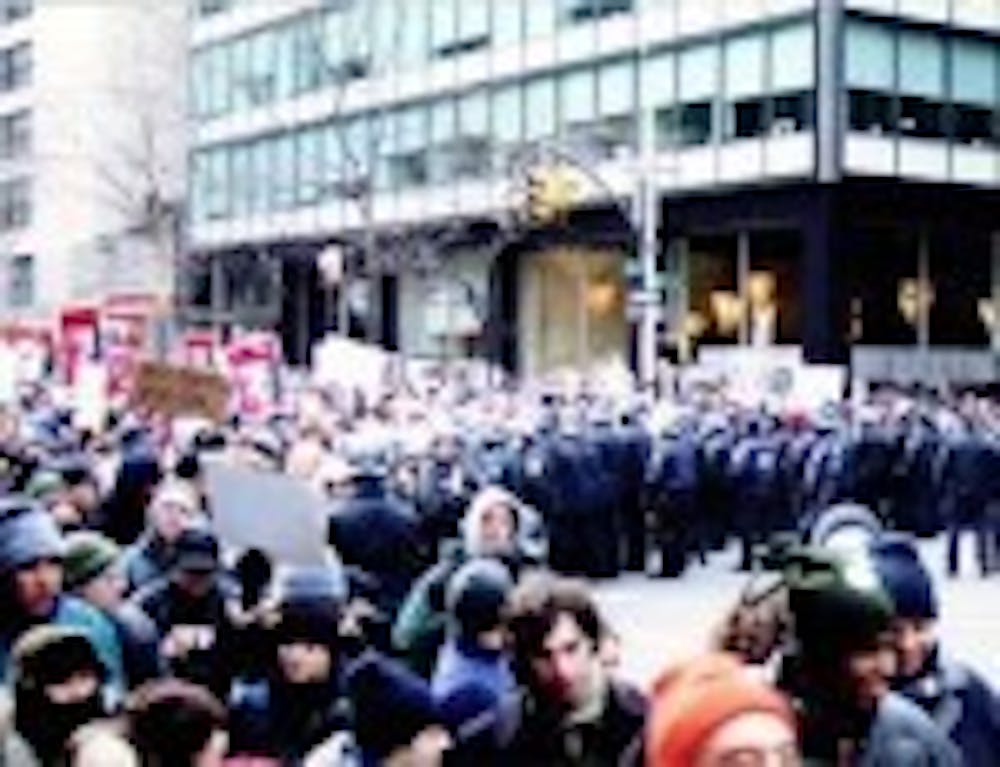Alisa Tavarez clutched her mother's hand as she walked through the thousands of people crammed in the streets of Manhattan. All around her, protestors were raising high their signs and shouting at police.
Above the noise, the 11-year-old shouted, "Bush says war! We say no!" The crowd grew silent for a moment, and the girl repeated her cry, "Bush says war!"
"We say no," the crowd responded, echoing a sentiment shared by thousands of protestors who filled New York City on Saturday as part of what is being called the largest global protest in history. Protestors from all over the United States and the globe poured into the streets for the noon rally, shutting down the East side of Manhattan for a large portion of the day.
Tavarez was joined by 200 Western New Yorkers who traveled to the city as part of a protest sponsored by area peace groups lead by the Western New York Peace Center.
"I think we really think we came together to make a change," said Colin O'Malley, a freshman undecided major who attends UB. "It shows we are all not in agreement with the Bush administration's march to war."
Phil Razem, a sophomore English education major at SUNY Fredonia, also did not agree with Bush but had different reasons for attending the rally.
"I came for personal success, so I know that there are other people who share my beliefs, and, with everyone that was out there today, I now know we are not the minority," said Razem.
The group represented a broad cross-section of people from Western New York, from high school- and college-aged students new to activism to middle-aged and senior citizen veterans of the Vietnam demonstrations.
"I think one of the immediate successes is the real diversity of ethnicity and age that are being brought together," said Don Sleight, 67, a 1968 UB alumnus. "I think it shows it's not just an isolated part of American society is fed up with Bush's policies."
However, Sleight was concerned over the relatively small number of UB students attending the rally. "I'm surprised that a school of 25,000 students can only muster a couple dozen people to go to something like this," he said. "UB used to be a hotbed for activism, so much so the campus would shut down."
O'Malley voiced concern over the representation of UB at the rally. "With so many thousands of undergraduates, we could do a much better job," he said. "There are four buses going to New York from the general Buffalo area; I think there could be twice as many going from UB alone."
Along with protestors native to the Western New York area were members of Buffalo's Iraqi House, a group composed of Iraqi refugees.
"I think the support shown by the world is just beautiful," said Bashard Jawad, a member of the Iraqi House and a refugee from the Hussein regime. "The millions of people all over the world coming together makes me feel like war in Iraq is not necessarily imminent."
Charles Cobb, director of the WNY Peace Center, said he was particularly excited about the variety and attitude of the Western New York group.
"Most people didn't come as Buffalo citizens," Cobb said. "I think we came here as global citizens, and as such, we feel empowered as we work together."
Cobb was also one of the few in the Buffalo group to make it to the main rally point at First Avenue and 49th Street, where a stage was set up for the many speakers at the rally.
He described the scene as a sea of people filling every intersection from the stage to where he was at 56th Street and beyond, with signs denouncing war. Some protesters carried large paper-mache puppets of President George W. Bush, Vice President Dick Cheney and Secretary of State Colin Powell.
"One of the most moving things I saw was when Pete Seger, as old as he is, led the crowd in "Somewhere Over the Rainbow,'" Cobb said. "It was magic."
Further away on Third Avenue, the streets were just as packed with people chanting, pounding drums and dancing. According to an officer on the scene, protestors crowded on top of newsstands, traffic lights and construction equipment. He said police moved to break up the crowd into "pens" by separating groups of protestors at various intersections to allow traffic to pass and break up the protest.
The crowd chanted, "Let us through," and many tried unsuccessfully to break through the metal barriers.
According to Jim Whitlock, a senior organizer with Buffalo Peace, less than 350 people were arrested citywide, despite the massive number that participated in the protest. Of the Western New Yorkers at the rally, he said only one was arrested for assaulting a police officer.
Measuring the success of the protests based on the sheer number of protestors may make the demonstrations seem wildly successful, but many are exercising cautious optimism.
"Real success will come when we see if policy makers' decisions begin to change," Sleight said, "but the magnitude of this protest has to make a difference."
"I don't know if these protests will change that we're going to war," said Kristopher Hite, a sophomore biochemistry major at SUNY Fredonia. "But I think we will start to raise awareness for these issues."





